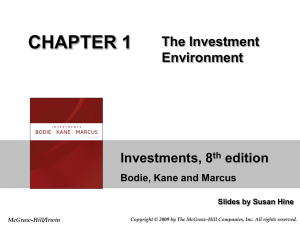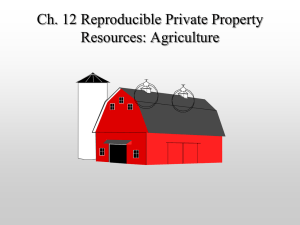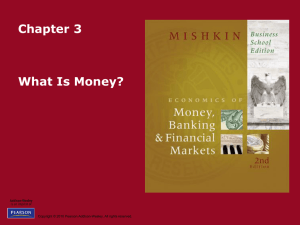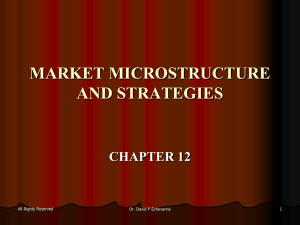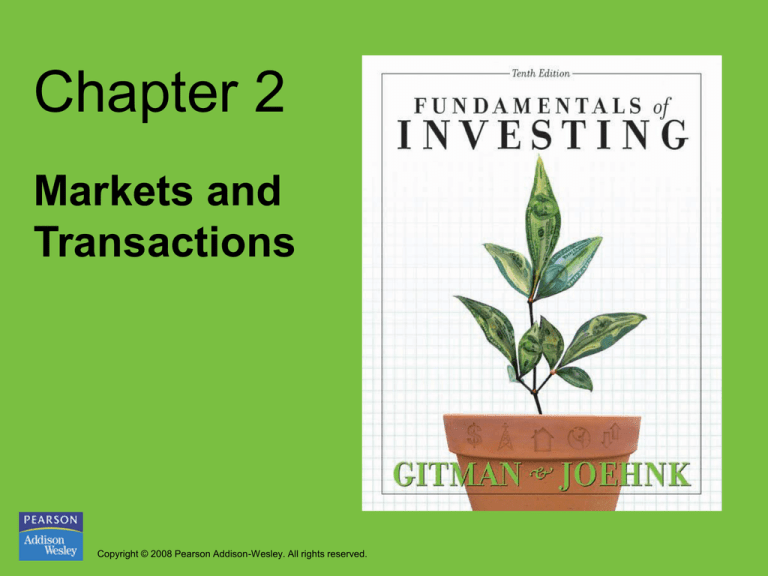
Chapter 2
Markets and
Transactions
Copyright © 2008 Pearson Addison-Wesley. All rights reserved.
Markets and Transactions
• Learning Goals
1. Identify the basic types of securities markets
and describe the IPO process.
2. Explain the characteristics of broker markets.
3. Understand dealer markets, alternative trading
systems, and the general conditions of
securities markets.
Copyright © 2008 Pearson Addison-Wesley. All rights reserved.
2-2
Markets and Transactions
• Learning Goals (cont’d)
4. Review the key aspects of global securities
markets, including the risks associated with
foreign investments.
5. Discuss trading hours and regulation of
securities markets.
6. Explain long purchases, margin transactions
and short sales.
Copyright © 2008 Pearson Addison-Wesley. All rights reserved.
2-3
Types of Markets
• Money Markets: the market where short-term
securities are bought and sold
• Capital Market: the market where long-term
securities such as stocks and bonds are bought
and sold
• Primary Market: the market in which new issues
of securities are sold to the public
• Secondary Market: the market in which securities
are traded after they have been issued
Copyright © 2008 Pearson Addison-Wesley. All rights reserved.
2-4
Primary Markets
• Initial Public Offering (IPO)
– First public sale of a company’s stock
– Requires SEC approval
• Three Choices to Market Securities in
Primary Market
– Public offering
– Rights offering
– Private Placement
Copyright © 2008 Pearson Addison-Wesley. All rights reserved.
2-5
Going Public: The IPO Process
• Underwriting the offering: promoting the stock and
facilitating the sale of the company’s shares
• Prospectus: registration statement describing the issue
and the issuer
• Red Herring: preliminary prospectus available during the
waiting period
• Quiet Period: time period after prospectus is filed when
company must restrict what is said about the company
• Road Show: series of presentations to potential investors
Copyright © 2008 Pearson Addison-Wesley. All rights reserved.
2-6
The Investment Banker’s Role
• Underwriting the Issue: purchases the security at agreedon price and bears the risk of reselling it to the public
• Underwriting Syndicate: group formed by investment
banker to share the financial risk of underwriting
• Selling Group: other brokerage firms that help the
underwriting syndicate sell issue to the public
• Tombstone: public announcement of issue and role of
participants in underwriting process
• Investment Banker Compensation: typically in the form
of a discount on the sale price of the securities
Copyright © 2008 Pearson Addison-Wesley. All rights reserved.
2-7
Figure 2.2 The Selling Process
for a Large Security Issue
Copyright © 2008 Pearson Addison-Wesley. All rights reserved.
2-8
Secondary Markets
• Secondary Market: the market in which securities are
traded after they have been issued
Role of Secondary Markets
– Provides liquidity to security purchasers
– Provides continuous pricing mechanism
• Securities Exchanges: forums where buyers and sellers
of securities are brought together to execute trades
• Nasdaq Market: employs an all-electronic trading platform
to execute trades
• Over-the-counter (OTC) Market: involves trading in
smaller, unlisted securities
Copyright © 2008 Pearson Addison-Wesley. All rights reserved.
2-9
Broker Markets and Dealer Markets
• Broker Markets: consists of national and regional
securities exchanges
– 60% of the total dollar volume of all shares in U.S. stock market
trade here
– New York Stock Exchange (NYSE) is largest and most well-known
– Trades are executed when a buyer and a seller are brought
together by a broker and the trade takes place directly between
the buyer and seller
• Dealer Markets: consists of both the Nasdaq market and
the OTC market
– Trades are executed with a dealer (market maker) in the middle.
Sellers sell to a market maker at a stated price. The market
maker then offers the securities to a buyer.
Copyright © 2008 Pearson Addison-Wesley. All rights reserved.
2-10
Figure 2.3 Broker and Dealer Markets
Copyright © 2008 Pearson Addison-Wesley. All rights reserved.
2-11
Broker Markets
• The New York Stock Exchange (NYSE)
–
–
–
–
–
Largest stock exchange—over 2,700 companies
Over 350 billion shares of stock traded in 2005
Accounts for 90% of stocks traded on exchanges
Specialists make transactions in key stocks
Strictest listing policies
• The American Exchange (AMEX)
– About 700 companies and 4% of stocks traded
– Major market for Exchange Traded Funds
– Typically smaller and younger companies who cannot
meet stricter listing requirements for NYSE
Copyright © 2008 Pearson Addison-Wesley. All rights reserved.
2-12
Broker Markets (cont’d)
• Regional Stock Exchanges
– Typically lists between 100–500 companies, usually with local and
regional appeal
– Listing requirements are more lenient than NYSE
– Often include stocks that are also listed on NYSE or AMEX
– Best-known: Midwest, Pacific, Philadelphia, Boston,
and Cincinnati
• Options Exchanges
– Allows trading of options
– Best-known: Chicago Board Options Exchange (CBOE)
• Futures Exchanges
– Allows trading of financial futures
– Best-known: Chicago Board of Trade (CBT)
Copyright © 2008 Pearson Addison-Wesley. All rights reserved.
2-13
Dealer Markets
• No centralized trading floor; comprised of market
makers linked by telecommunications network Both
IPOs and secondary distributions are sold on OTC
– 40% of the total dollar volume of all shares in U.S. stock market
trade here
– Both IPOs and secondary distributions are sold on OTC
• Bid Price: the highest price offered by market maker to
purchase a given security
• Ask Price: the lowest price at which a market maker is
willing to sell a given security
Copyright © 2008 Pearson Addison-Wesley. All rights reserved.
2-14
Dealer Markets
• Nasdaq
– Largest dealer market
– Lists large companies (Microsoft, Intel, Dell, eBay) and
smaller companies
• Over-the-counter (OTC) Bulletin Board
– Lists smaller companies that cannot or don’t wish to be
listed on Nasdaq
– Companies are regulated by SEC
• Over-the-counter (OTC) Pink Sheets
– Lists smaller companies that are not regulated by SEC
– Liquidity is minimal or almost non-existent
– Very risky; many nearly worthless stocks
Copyright © 2008 Pearson Addison-Wesley. All rights reserved.
2-15
Alternative Trading Systems
• Third Market
– Large institutional investors go through market makers that are not
members of a securities exchange
– Institutional investors (mutual funds, life insurance companies,
pension funds) receive reduced trading costs due to large size
of transactions
• Fourth Market
– Large institutional investors deal directly with each other to bypass
market makers
– Electronic Communications Networks (ECNs) allow direct trading
– ECNs most effective for high-volume, actively traded securities
Copyright © 2008 Pearson Addison-Wesley. All rights reserved.
2-16
General Market Conditions
• Bull Market
–
–
–
–
–
Favorable markets
Rising prices
Investor/consumer optimism
Economic growth and recovery
Government stimulus
• Bear Market
–
–
–
–
–
Unfavorable markets
Falling prices
Investor/consumer pessimism
Economic slowdown
Government restraint
Copyright © 2008 Pearson Addison-Wesley. All rights reserved.
2-17
Globalization of Securities Markets
• Diversification: the inclusion of a number of different
investment vehicles in a portfolio to increase returns or
reduce risks
• Use of International Securities Improves Diversification
– More industries and securities available
– Securities denominated in different currencies
– Opportunities in rapidly expanding economies
• International Investment Performance
– Opportunities for high returns
– Foreign securities markets do not necessarily move with the U.S.
securities market
– Foreign securities markets tend to be more risky than U.S.
markets
Copyright © 2008 Pearson Addison-Wesley. All rights reserved.
2-18
Globalization of
Securities Markets (cont’d)
• Indirect Ways to Invest in Foreign Securities
– Purchase shares of U.S.-based multinational with
substantial foreign operations
• Direct Ways to Invest in Foreign Securities
– Purchase securities on foreign stock exchanges
– Buy securities of foreign companies that trade on U.S.
stock exchanges
– Buy American Depositary Receipts (ADRs): dollar
denominated receipts for stocks of foreign companies
held in vaults of banks
Copyright © 2008 Pearson Addison-Wesley. All rights reserved.
2-19
Risks of International Investing
• Usual Investment Risks Still Apply
• Government Policies Risks
–
–
–
–
Unstable foreign governments
Different laws in trade, labor or taxation
Different economic and political conditions
Less stringent regulation of foreign securities markets
• Currency Exchange Rate Risks
– Value of foreign currency fluctuates compared to
U.S. dollar
– Value of foreign investments can go up and down with
exchange rate fluctuations
Copyright © 2008 Pearson Addison-Wesley. All rights reserved.
2-20
Trading Hours of Securities Markets
• Regular Trading Session for U.S. Exchanges
and Nasdaq
– 9:30 A.M. to 4:00 P.M. Eastern time
• Extended-Hours Electronic-Trading Sessions
– NYSE: 4:15 to 5:00 P.M. Eastern time
– Nasdaq: 4:00 P.M. to 6:30 P.M. Eastern time
– Orders only filled if matched with identical
opposing orders
– 24-hour market probably in near future
Copyright © 2008 Pearson Addison-Wesley. All rights reserved.
2-21
Regulation of Securities
Markets
• Insider Trading
– Use of nonpublic information about a company to make
profitable securities transactions
• Blue Sky Laws
– Laws imposed by individual states to regulate sellers of
securities
– Intended to prevent investors from being sold nothing
but “blue sky”
Copyright © 2008 Pearson Addison-Wesley. All rights reserved.
2-22
Regulation of Securities
Markets
• Securities Act of 1933
– Required full disclosure of information by companies
• Securities Act of 1934
– Established SEC as government regulatory body
• Maloney Act of 1938
– Allowed self-regulation of securities industry through trade
associations such as the National Association of Securities
Dealers (NASD)
• Investment Company Act of 1940
– Created & regulated mutual funds
Copyright © 2008 Pearson Addison-Wesley. All rights reserved.
2-23
Regulation of Securities
Markets
• Investment Advisors Act of 1940
– Required investment advisers to make full disclosure about their
backgrounds and their investments, as well as register with
the SEC
• Securities Acts Amendments of 1975
– Abolished fixed-commissions and established an electronic
communications network to make stock pricing more competitive
• Insider Trading and Fraud Act of 1988
– Prohibited insider trading on nonpublic information
• Sarbanes-Oxley Act of 2002
– Tightened accounting and audit guidelines to reduce corporate
fraud
Copyright © 2008 Pearson Addison-Wesley. All rights reserved.
2-24
Basic Types
of Securities Transactions
• Long Purchase
– Investor buys and holds securities
– “Buy low and sell high”
– Make money when prices go up
Copyright © 2008 Pearson Addison-Wesley. All rights reserved.
2-25
Basic Types
of Securities Transactions (cont’d)
• Margin Trading
– Uses borrowed funds to purchase securities
– Currently owned securities used as collateral for margin
loan from broker
– Margin requirements set by Federal Reserve Board
• Determines the minimum amount of equity required
• On $4,445 purchase with 50% margin requirement, investor
puts up $2,222.50 and broker will lend remaining $2,222.50
– Can be used for common stocks, preferred stocks,
bonds, mutual funds, options, warrants and futures
Copyright © 2008 Pearson Addison-Wesley. All rights reserved.
2-26
Table 2.4 Initial Margin Requirements
for Various Types of Securities
Copyright © 2008 Pearson Addison-Wesley. All rights reserved.
2-27
Margin Trading
• Advantages
– Allows use of financial leverage
– Magnifies profits
•
Disadvantages
– Magnifies losses
– Interest expense on margin loan
– Margin calls
Copyright © 2008 Pearson Addison-Wesley. All rights reserved.
2-28
Margin Formulas
• Basic Margin Formula
Value of securities Debit balance
Margin
Value of securities
V D
V
• Example of Using Margin
V D
$6,500 $1,200
Margin
0.815 81.5%
V
$6,500
Copyright © 2008 Pearson Addison-Wesley. All rights reserved.
2-29
Table 2.3 The Effect of Margin
Trading on Security Returns
Copyright © 2008 Pearson Addison-Wesley. All rights reserved.
2-30
Margin Formulas (cont’d)
• Return on Invested Capital
Return on
invested capital
from a margin
transaction
Total
Total
Market
Market
current
interest
value of
value of
income
paid on
securities
securities
received
margin loan
at sale
at purchase
Amount of equity at purchase
• Example of Return on Invested Capital
Return on
$100 $125 $7,500 $5,000
$2,475
invested capital
0.99 99%
from a margin
$2,500
$2,500
transaction
Copyright © 2008 Pearson Addison-Wesley. All rights reserved.
2-31
Basic Types
of Securities Transactions
• Short Selling
– Investor sells securities they don’t own
– Investor borrows securities from broker
– Broker lends securities owned by other investors that
are held in “street name”
– “Sell high and buy low”
– Investors make money when stock prices
go down
Copyright © 2008 Pearson Addison-Wesley. All rights reserved.
2-32
Short Selling
• Advantages
– Chance to profit when stock price declines
• Disadvantages
– Limited return opportunities: stock price cannot go
below $0.00
– Unlimited risks: stock price can go up an
unlimited amount
– If stock price goes up, short seller still needs to buy
shares to pay back the “borrowed” shares to the broker
– Short sellers may not earn dividends
Copyright © 2008 Pearson Addison-Wesley. All rights reserved.
2-33
Table 2.5
The Mechanics of a Short Sale
Copyright © 2008 Pearson Addison-Wesley. All rights reserved.
2-34
Chapter 2 Review
• Learning Goals
1. Identify the basic types of securities markets
and describe the IPO process.
2. Explain the characteristics of broker markets.
3. Understand the dealer markets, alternative
trading systems, and the general conditions of
securities markets.
Copyright © 2008 Pearson Addison-Wesley. All rights reserved.
2-35
Chapter 2 Review (cont’d)
• Learning Goals (cont’d)
4. Review the key aspects of global securities
markets, including risks associated with foreign
investments.
5. Discuss trading hours and regulation of
securities markets.
6. Explain long purchases, margin transactions
and short sales.
Copyright © 2008 Pearson Addison-Wesley. All rights reserved.
2-36
Chapter 2
Additional
Chapter Art
Copyright © 2008 Pearson Addison-Wesley. All rights reserved.
Figure 2.1 Cover of a Preliminary
Prospectus for a Stock Issue
Copyright © 2008 Pearson Addison-Wesley. All rights reserved.
2-38
Table 2.1 Annual IPO Data, 1996–
2005
Copyright © 2008 Pearson Addison-Wesley. All rights reserved.
2-39
Table 2.2 Important Federal
Securities Laws
Copyright © 2008 Pearson Addison-Wesley. All rights reserved.
2-40
Table 2.6 Margin Positions on
Short Sales
Copyright © 2008 Pearson Addison-Wesley. All rights reserved.
2-41



